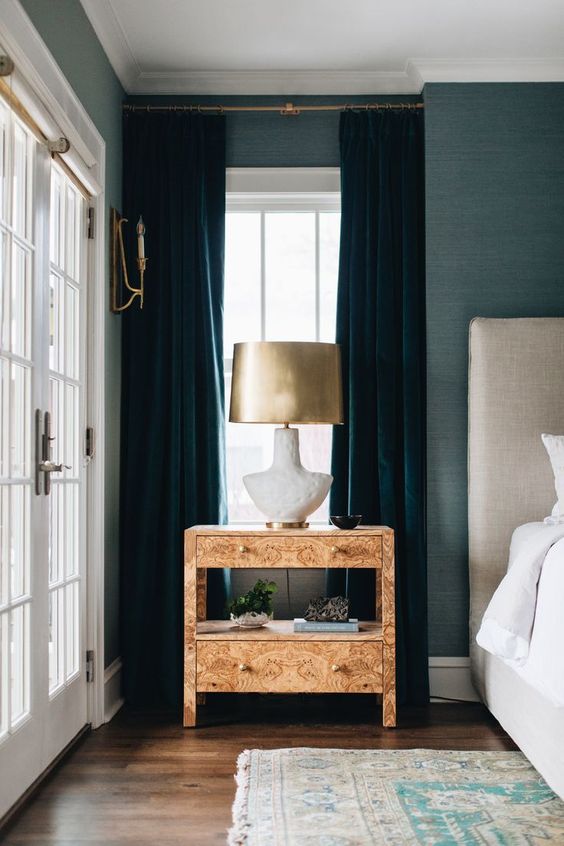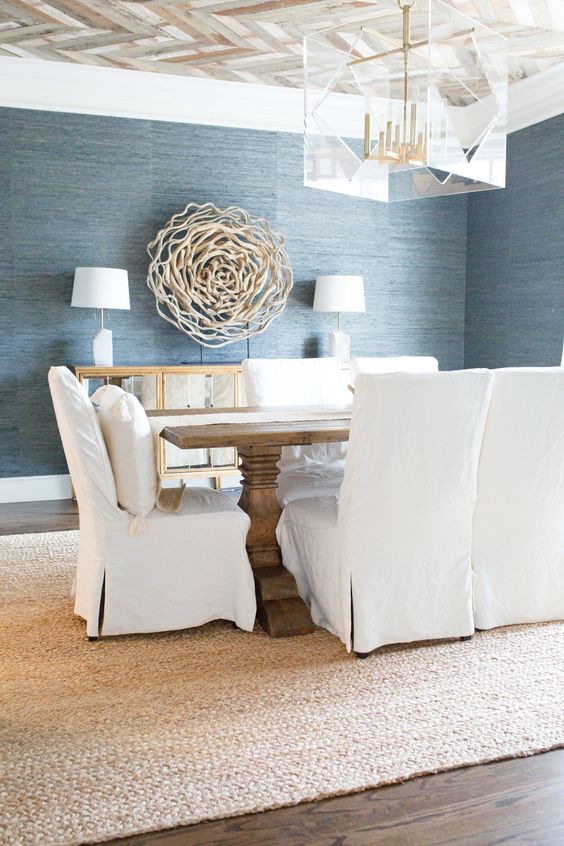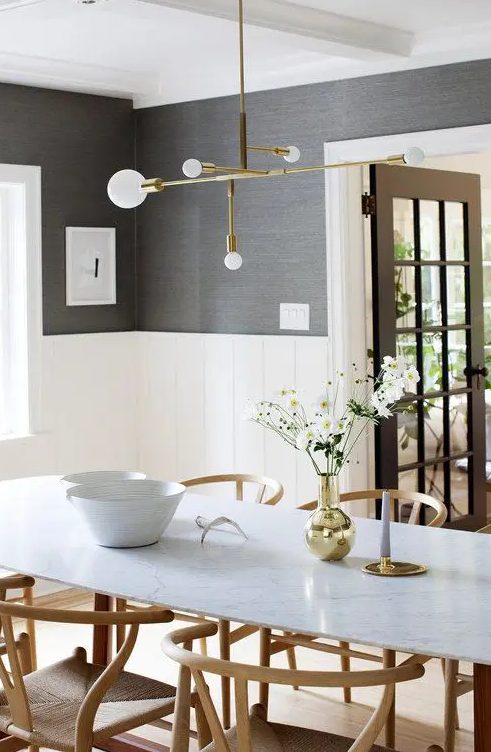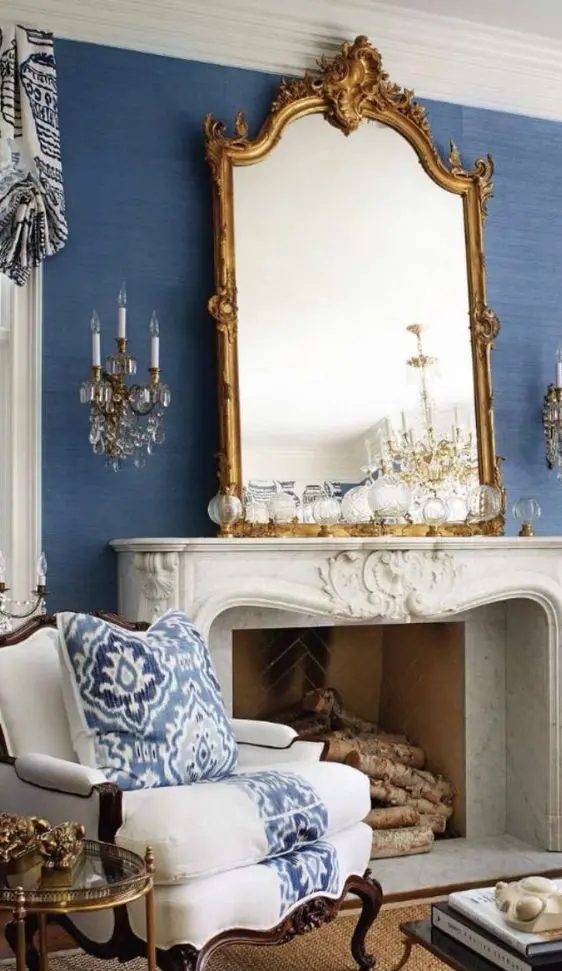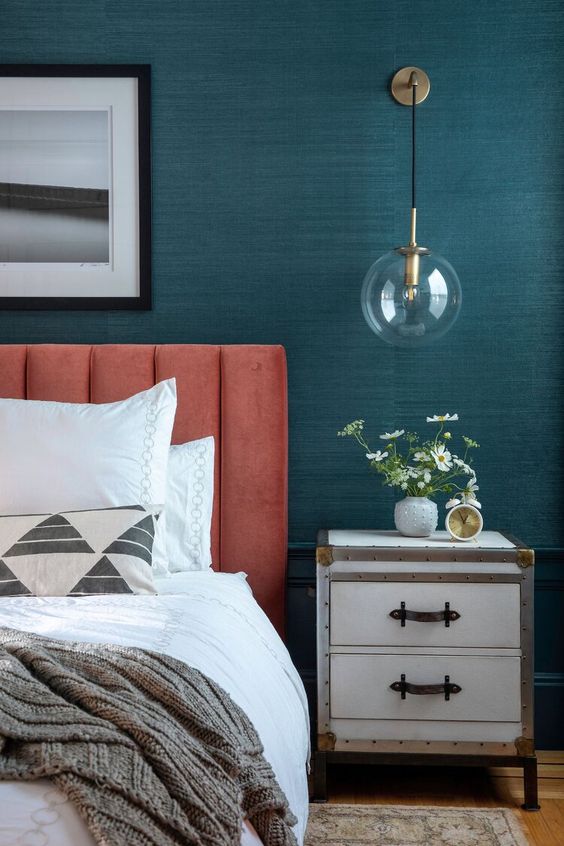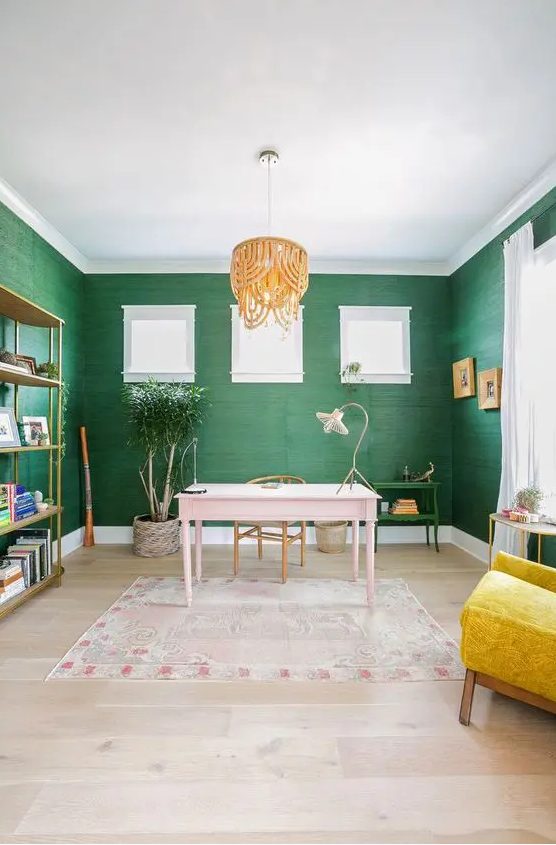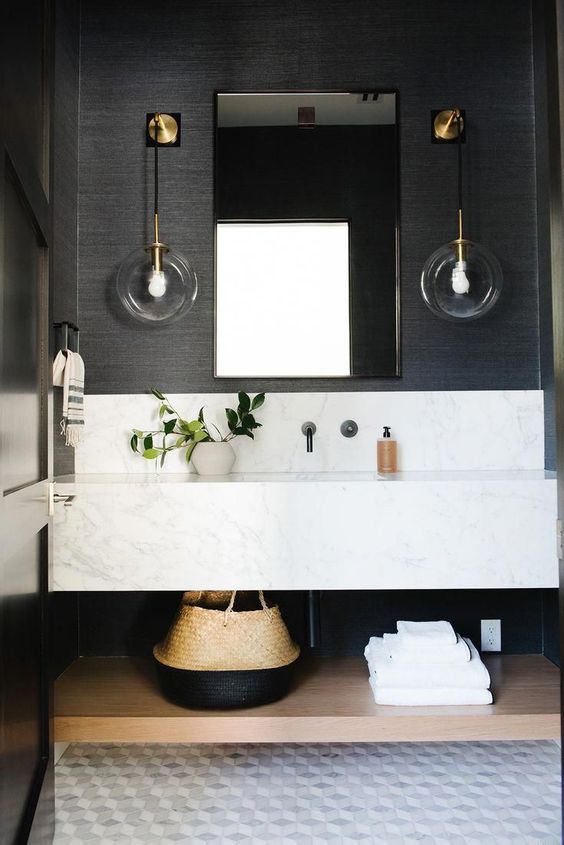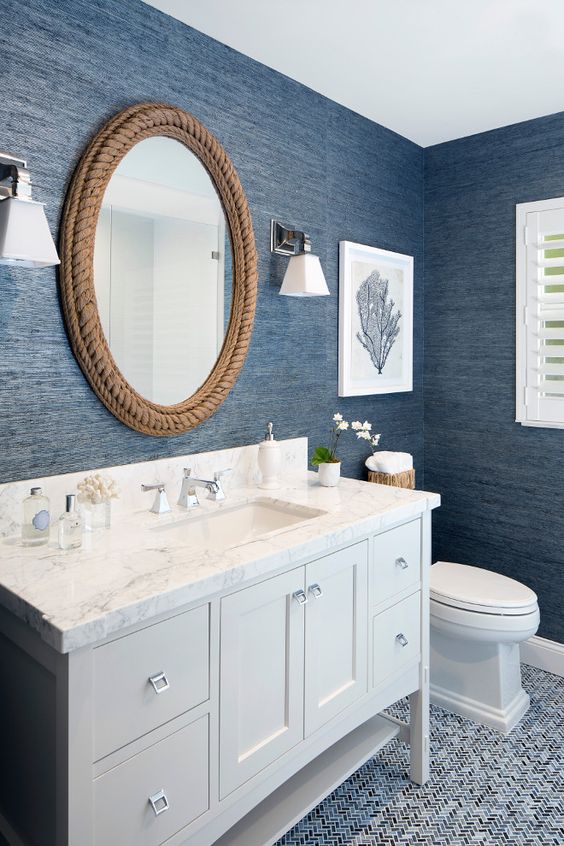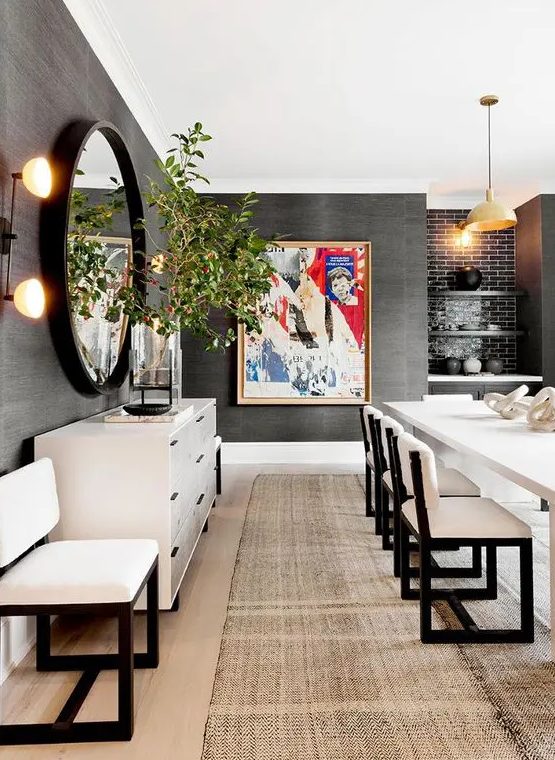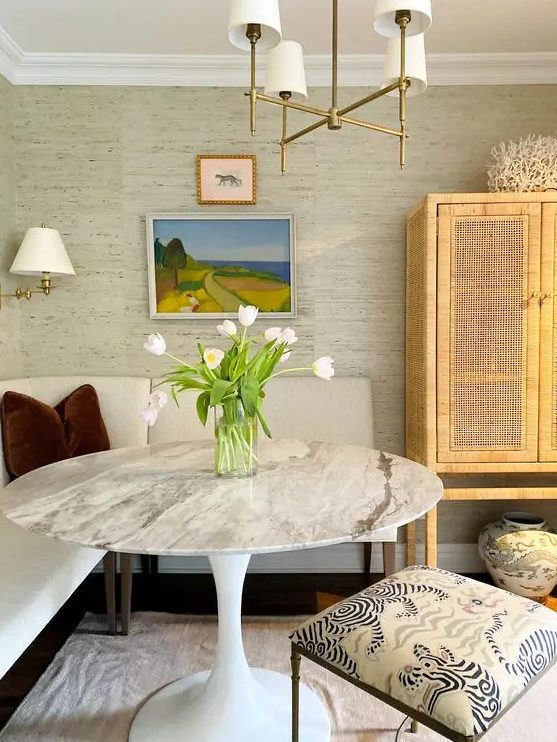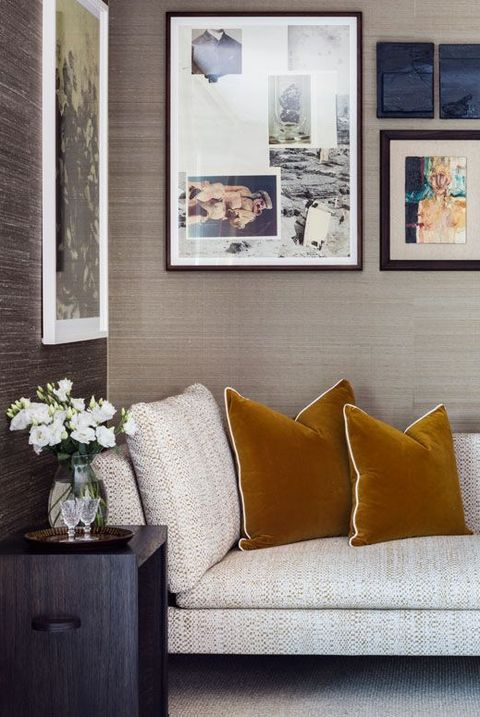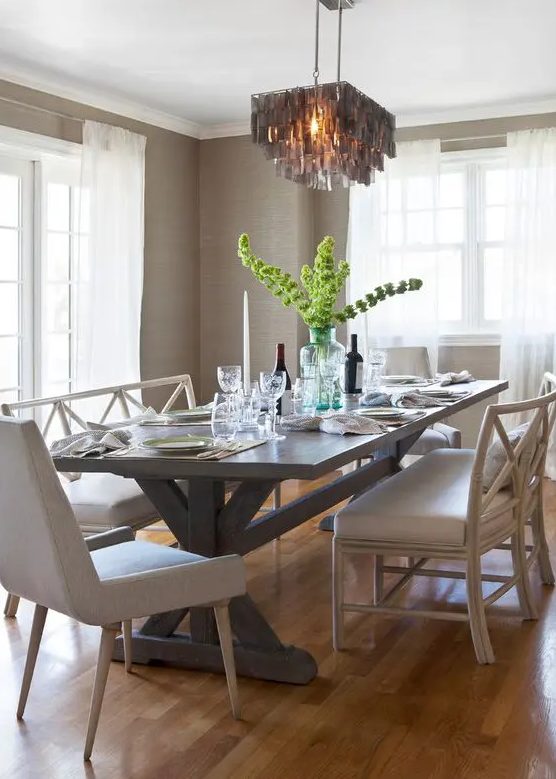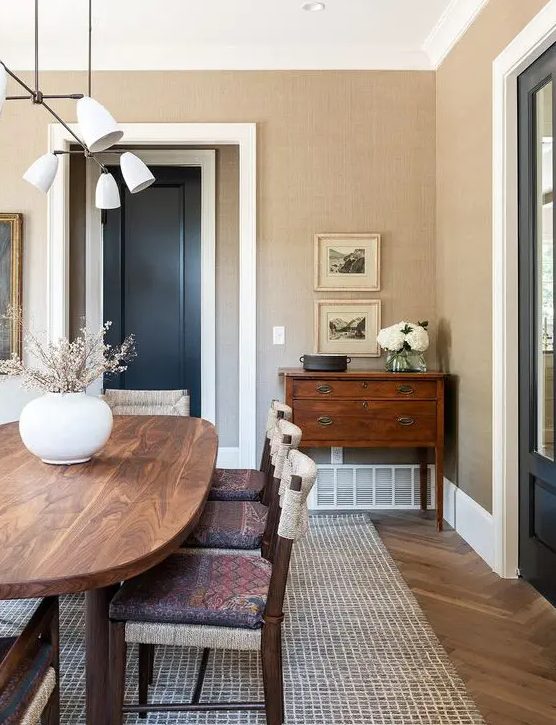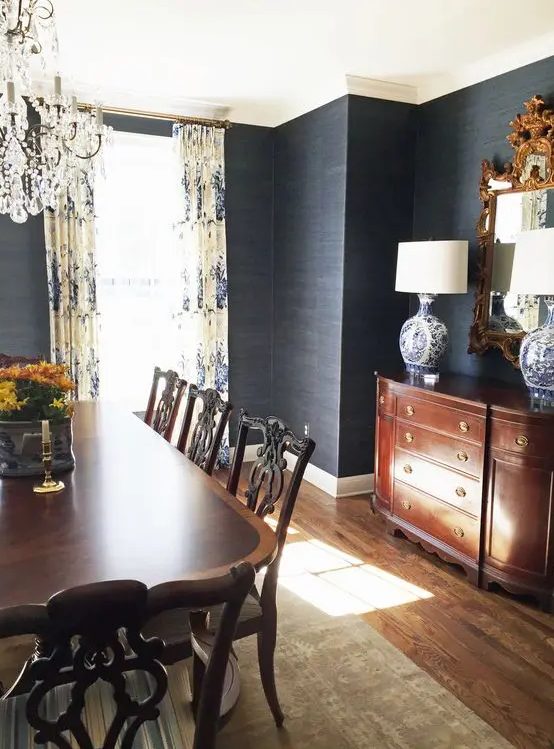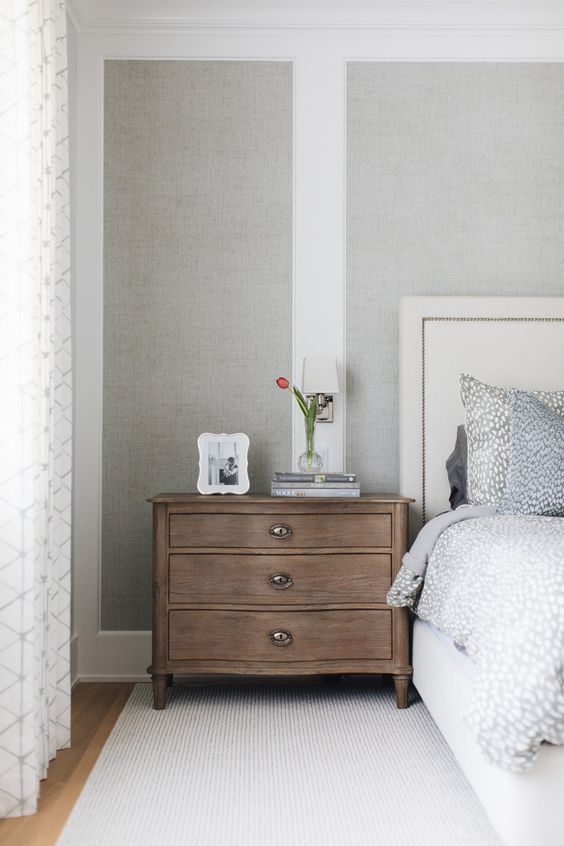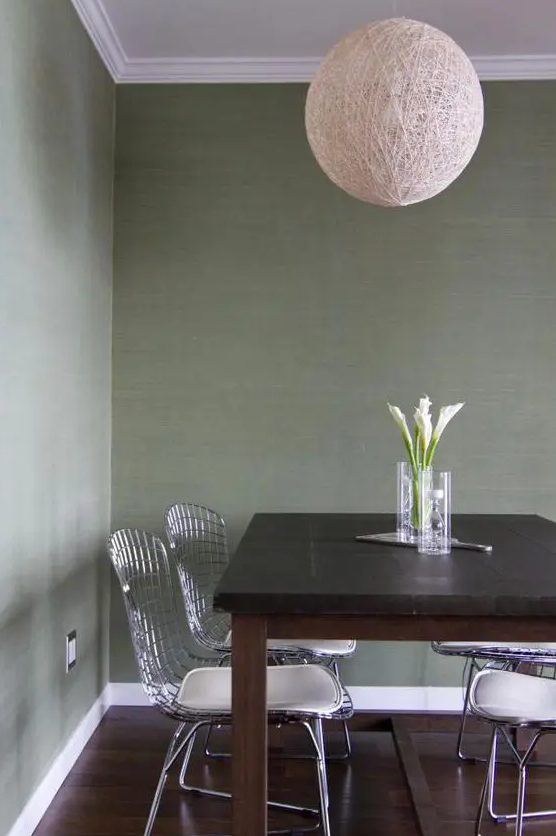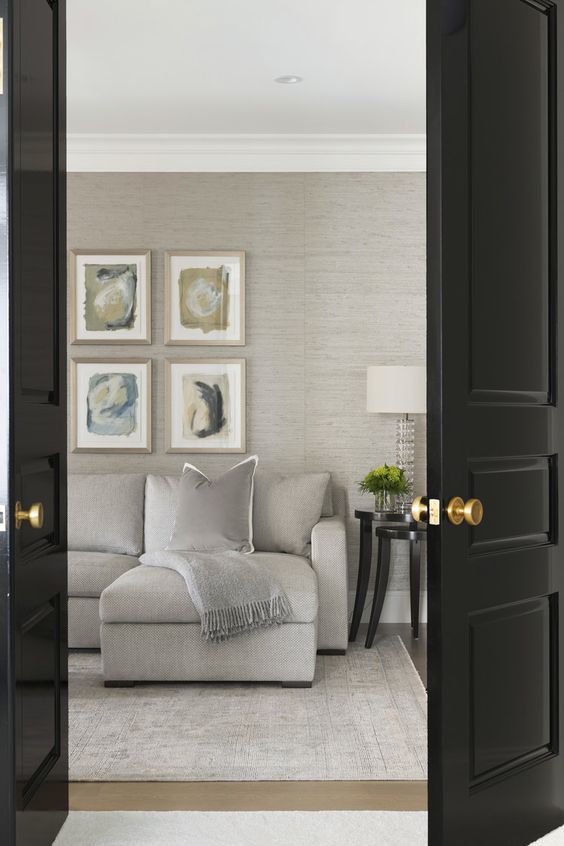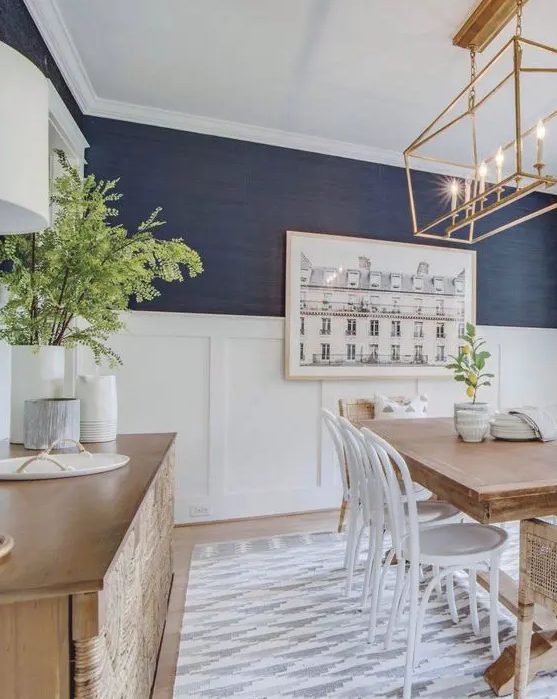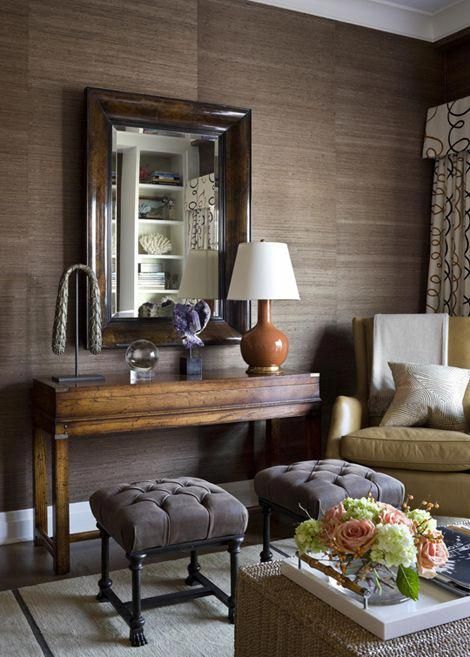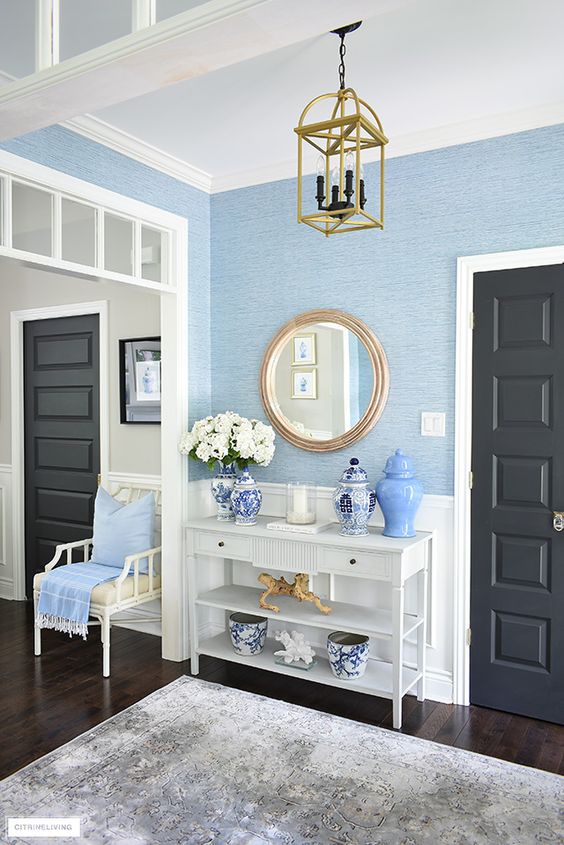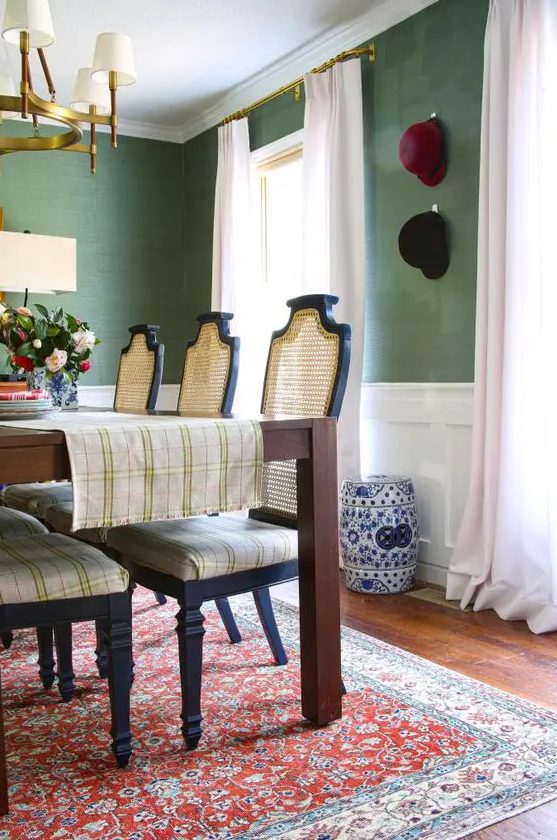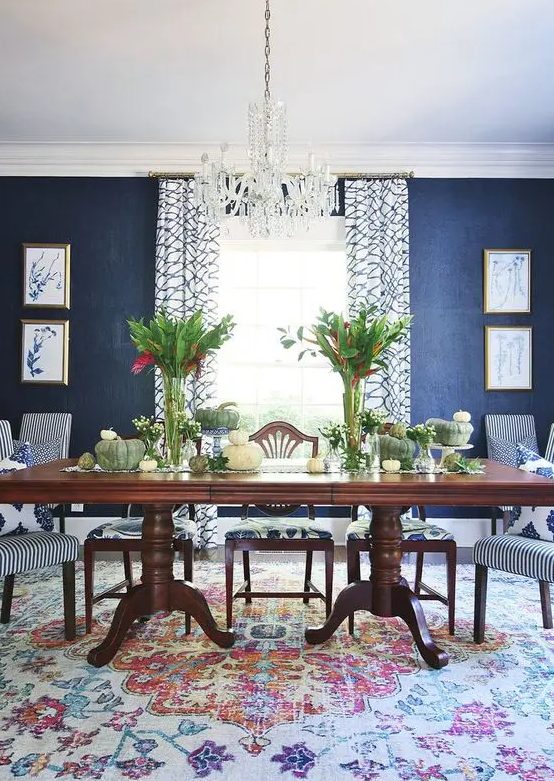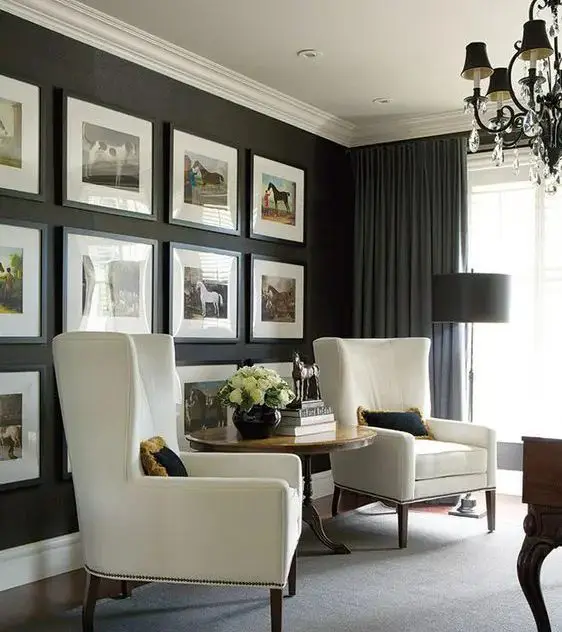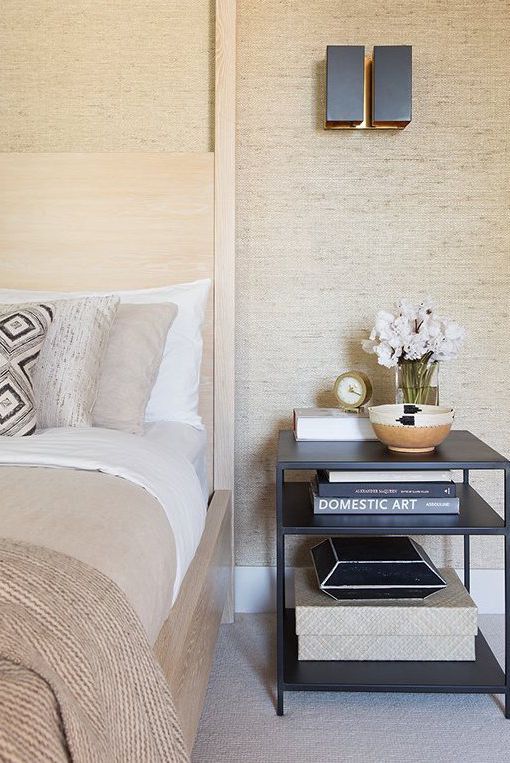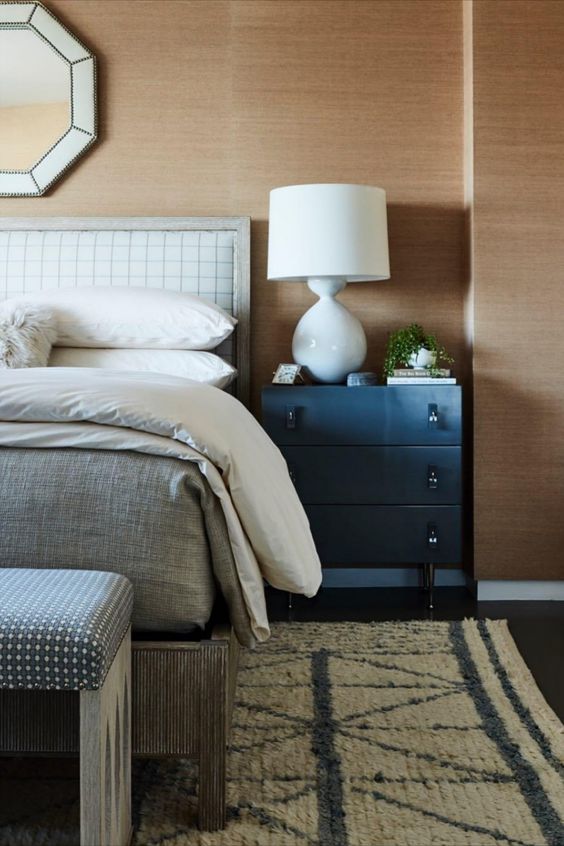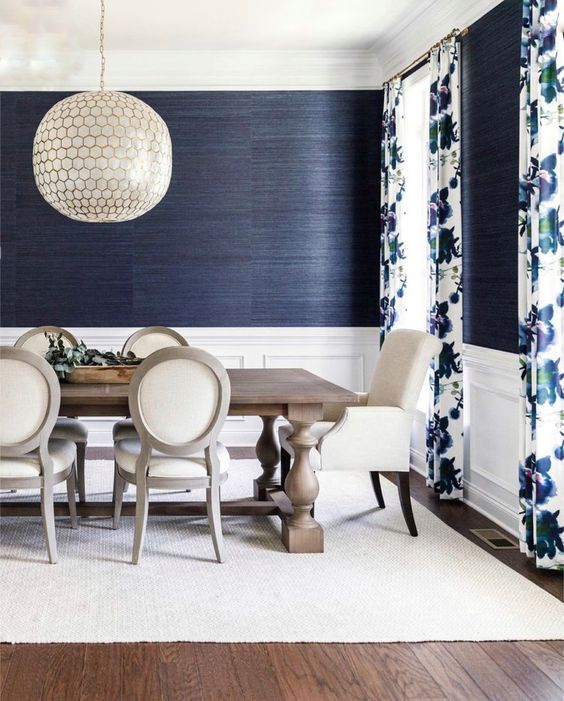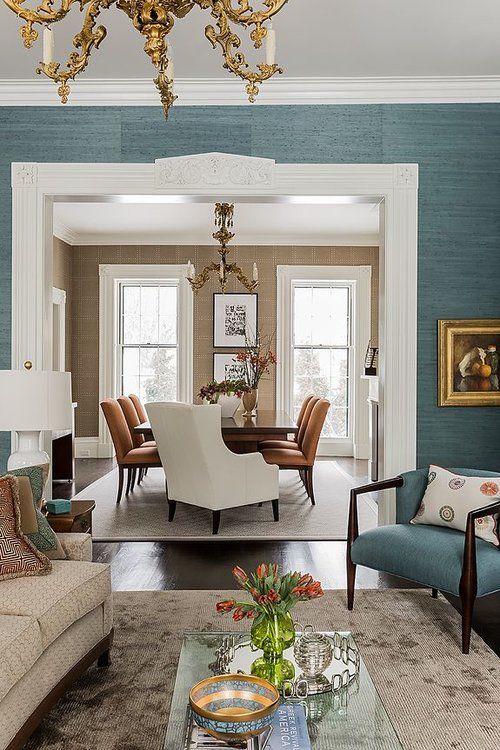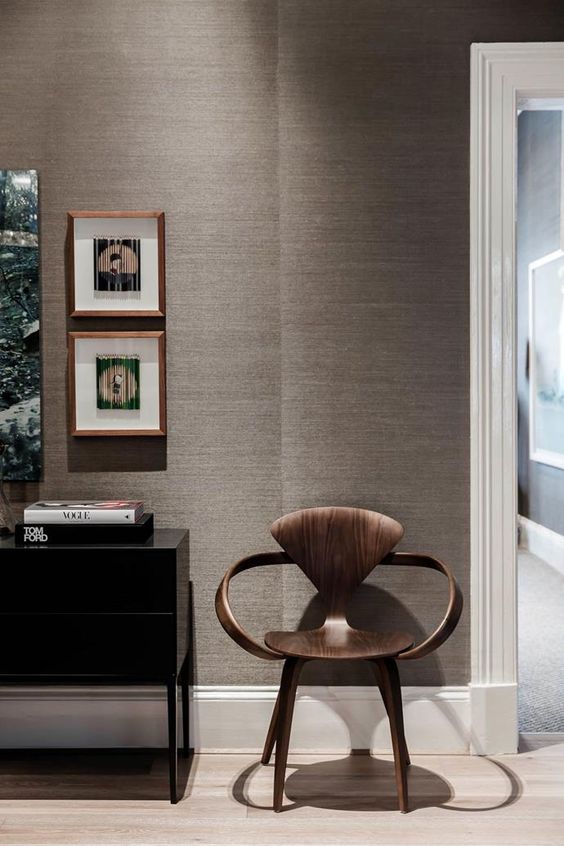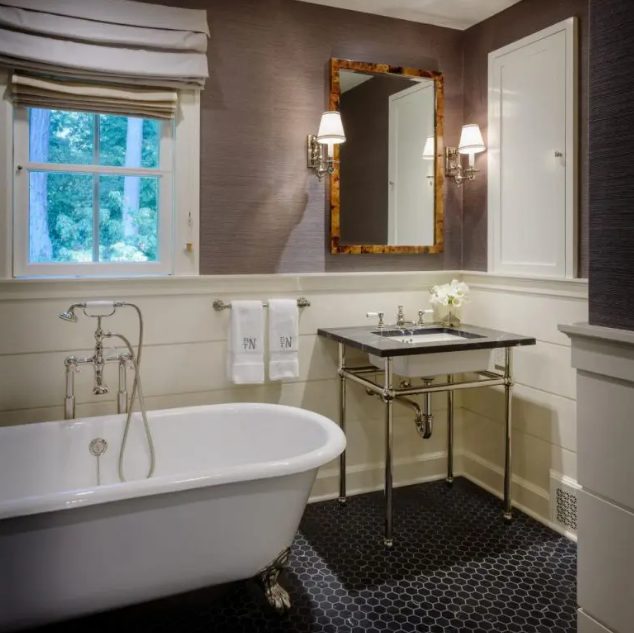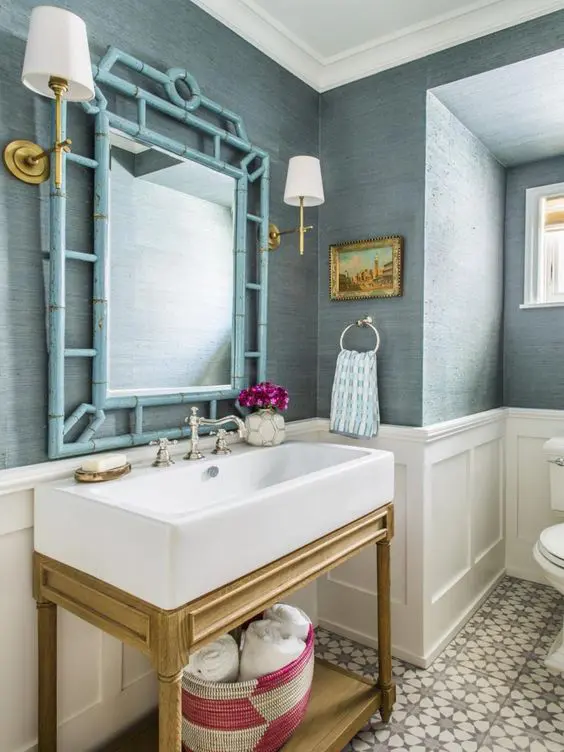Wallpaper trend is back and we see more and more wallpaper accent walls in various interiors. Homeowners go for different prints, patterns, colors and looks but I offer you a unique solution – textural wallpaper as providing textures is a hot current trend. Grasscloth wallpaper is that unique solution with plenty of texture, with various pros and cons that we are to consider before choosing.
What’s Grasscloth Wallpaper?
Grasscloth wallpaper is wallpaper made of fibers of arrowroot, bamboo hemp, jute, raffia, reeds, and sea grass hand-woven together in a complex framework typically using lightweight cotton threads and fastened on a thin rice paper backing. The specific pattern of the grasscloth can either be horizontal or vertical, although horizontal is the most popular style of grasscloth pattern.
A beautiful bedroom with blue grasscloth wallpaper, teal velvet curtains, a neutral upholstered bed, a light-colored nightstand and a gold lamp.
A beautiful dining room with blue grasscloth wallpaper, a stained dining table, chairs wiht white covers, a faceted chandelier and some cool lamps.
A beautiful dining room with grey grasscloth wallpaper and planked wainscoting, a white stone dining table, wooden chairs and a brass chandelier.
A bold and refined living room with blue grasscloth wallpaper, an antique fireplace, a mirror in an ornated frame, wall sconces and exquisite furniture.
A bold bedroom with teal grasscloth wallpaper, a coral bed with pretty bedding, a sconce and a white nightstand with blooms.
A bright home office with green grasscloth wallpaper, a pink desk, a yellow chair, a beaded chandelier and a brass storage unit.
A chic bathroom with black grasscloth wallpaper, a white slab vanity and sink, a mirror and cool sconces and an open shelf is elegant.
A coastal bathroom with navy grasscloth wallpaper, a white vanity with a stone countertop, white appliances and a mirror in a rope frame.
A contasting dining room with black grasscloth wallpaper, creamy furniture, built-in shelves and a mirror in a black frame.
A cozy dining nook with neutral grasscloth wallpaper, a creamy banquette seating, a round marble table and a cane storage unit.
What Are Special Features Of Grasscloth Wallpaper?
Every roll of grasscloth wallpaper will be different, with its own distinctive pattern and texture. The fibers will vary in size and shade between rolls (even when bought from the same batch, in the same color and pattern). These inconsistencies are not defects in the product, but rather a function of the manual production process and the natural materials from which it is constructed (with the dye taking unevenly, depending on the fibers).
Grasscloth wallpaper has the subtle smell of grass. This natural and earthy scent will fade with time and is, for many, part of the appeal of authentic grasscloth. Whilst not an overpowering smell, it is worth bearing in mind when considering whether grasscloth wallpaper is the right choice for you.
A living room with tan grasscloth wallpaper walls, a cool gallery wall, a neutral sofa and colorful pillows plus a dark-stained cabinet.
A lovely neutral dining room with farmhouse touches, with greige grasscloth wallpaper, a trestle table and neutral chairs and a tassel chandelier.
A mid-century modern dining space with tan grasscloth wallpaper, a stained table and credenza, pretty chairs and a vintage chandelier.
A moody and refined vintage dining room with black grasscloth wallpaper, dark-stained vintage furniture, a mirror in an ornated frame and a crystal chandelier.
A neutral bedroom with grey grasscloth wallpaper, a stained nightstand, a white bed with grey bedding is soothing and cool.
A simple dining space with green grasscloth wallpaper, a dark-stained table, wire chairs and a yarn ball lamp.
A sophisticated living room with greige grasscloth wallpaper, a neutral sofa, a gallery wall and a dark-stained side table with a lamp.
A stylish dining room with navy grasscloth wallpaper, white wainscoting, a stained wooden table and a credenza and white chairs.
A stylish nook with brown grasscloth wallpaper, a stained table, a mirror in a chic frame, a yellow chair, grey stools and blooms.
A stylish summer entryway with blue grasscloth wallpaper walls, a white vanity and gold touches plus a printed rug is amazing.
What Are Cons And Ways To Minimize Them?
Grasscloth wallpaper is very delicate. It is far more prone to ripping and tearing, and it scratches more easily, than traditional wallpaper. Its texture (and grassy scent) also make it a very attractive scratching post for cats. For this reason, think carefully before placing grasscloth wallpaper in a hallway or entrance (where it may receive knocks from passersby or furniture) or in a room where small children or pets are likely to paw at it. Instead, consider using grasscloth in a bedroom or on a single wall as a focal point.
Whilst the process of weaving no doubt gives grasscloth wallpaper its distinctive, earthly aesthetic, the labor intensive nature of the product is also reflected in its price tag. So it is unsurprising that this kind of wall covering is most often found in more luxurious homes and high-end hotels.
Grasscloth wallpaper is also very absorbent and that makes it prone to staining. Think carefully before installing it in a kitchen, bathroom or powder room or, if you have small children who like to draw on your walls, in a room – or at a height – they can access. If you are keen to use grasscloth wallpaper in a kitchen, bathroom or water closet though, there are several precautionary measures you can take. These include placing the wallpaper high up on the wall and installing a powerful extractor fan.
As a natural material, grasscloth wallpaper is porous, so in addition to liquids, it absorbs and holds scents. The smell of tobacco and strong food odors, such as fish, cooking fats, spices and fried food, will linger on the walls. In this respect, grasscloth wallpaper can be likened to having fabric drapes that cannot be taken out periodically and cleaned.
As we mentioned, grasscloth is made from natural materials, including arrowroot, seagrass and reed. If you or anyone in your family suffers from allergies, faux grasscloth wallpaper may be a better choice.
As a natural, untreated material, grasscloth wallpaper is more sensitive to the sunlight than traditional coverings. Consider installing the wallpaper in an interior room in the house that gets less natural light or one with blackout blinds or curtains, that can be drawn during the day. Alternatively, you may prefer to extend the life of your grasscloth wallpaper by investing in additional window treatments, such as the installation on the glass of a clear UV ray filtering film.
Installing natural grasscloth wallpaper can be a complicated, expensive and time-consuming process, requiring specialized expertise and tools. We recommend hiring a professional paper hanger, who has experience with this particular kind of wall covering. In particular, the walls will need more preparation than when dealing with traditional or faux grasscloth wallpaper.
The fact that grasscloth expands when wet also makes it harder to install than traditional or faux grasscloth wallpaper. Professionals experienced with grasscloth may choose to lightly wet the back of the sheets with water beforehand, to allow it to expand in advance, avoiding air bubbles forming on the wall and large sections of the paper needing to be smoothed out and readjusted later – which can be especially tricky, as grasscloth is so prone to tearing.
A vintage dining room with green grasscloth wallpaper, a dark-stained dining table, neutral and dark chairs and a brass chandelier.
A vintage dining room with navy grasscloth wallpaper, a dark-stained dining table, striped chairs, a crystal chandelier and greenery.
A vintage living room with black grasscloth wallpaper, creamy chairs and a chic gallery wall and a vintage chandelier.
A warm-colored neutral bedroom with a light-stained bed with neutral bedding, a black nightstand, a black and gold sconce and some blooms.
A welcoming bedroom with tan grasscloth wallpaper, a slate grey nightstand, a neutral bed with bedding and a white table lamp.
An elegant dining room with navy grasscloth wallpaper, white paneling, a stained dining table and neutral chairs, a pendant lamp.
An elegant living room with turquoise grasscloth wallpaper, neutral and turquoise furniture, elegant gold chandeliers and chic artworks.
An elegant space with greige grasscloth wallpaper, a black sideboard and a stained chair, a mini gallery wall and some books.
An exquisite vintage bathroom with taupe grasscloth wallpaper, white wainscoting, a clawfoot tub, a vintage free-standing sink and Roman shades.
Light blue grasscloth wallpaper goes nice with white paneling and gold touches, with a light-stained vanity.

